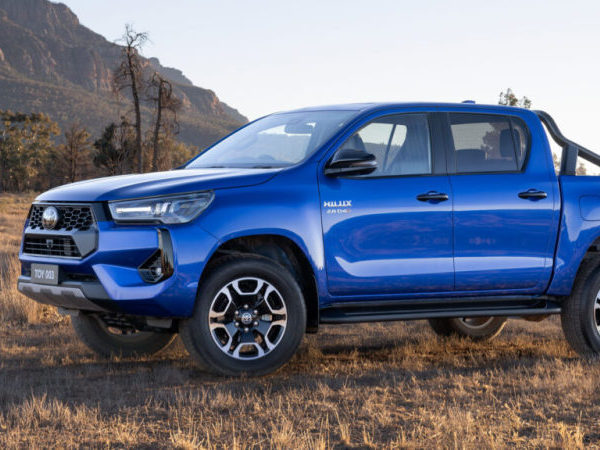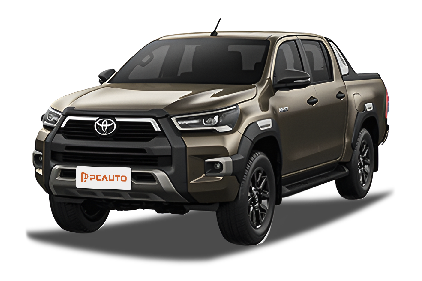Q
Is the 2018 Hilux good for families?
The 2018 Toyota Hilux, as a pickup truck, excels in hauling and off-road capabilities, but there are some factors to weigh for daily family use. It boasts a tough body structure and reliable powertrain, with 2.4L or 2.8L diesel engines that handle long drives and rough terrain well. However, as a family vehicle, its rear-seat comfort can't match traditional SUVs or MPVs—those seats are pretty upright, which might get tiring on longer trips. Also, the back seat space is on the tight side; if you've got a bigger family or need to fit child safety seats, it could feel cramped. On the flip side, its high ground clearance and strong cargo capacity make it great for families into outdoor stuff, like camping or hauling lots of gear. If family comfort is your top priority, the brand's Innova or Fortuner might be better picks—they're more tailored for family needs. All in all, the 2018 Hilux is a solid choice if you need something that handles both work and light family use, but for purely family-focused driving, you might want to go with a more comfort-oriented model instead.
Special Disclaimer: This content is published by users and does not represent the views or position of PCauto.
Related Q&A
Q
Is a 2018 Hilux reliable?
The 2018 Toyota Hilux has built a solid reputation in Malaysia for its reliability and durability. Under the hood, you'll find either a 2.4-liter or 2.8-liter turbocharged diesel engine—proven powertrains that deliver consistent performance, easily handling Malaysia's diverse road conditions whether you're navigating city streets or tackling rough rural tracks. The Hilux's tough chassis and practically tuned suspension can handle heavy loads, making it a great fit for both work and family use. Toyota's extensive after-sales network across Malaysia means maintenance is a breeze with readily available parts, really enhancing the long-term ownership experience. On top of that, the Hilux holds its value well in the used car market, a clear sign that buyers trust its quality. If you're in the market for a tough pickup with reasonable running costs, the 2018 Hilux is definitely worth a look. Of course, when buying used, it's always smart to check the service records and actual condition to make sure it performs as expected.
Q
What kind of engine is in the 2018 Toyota Hilux SR5?
The 2018 Toyota Hilux SR5 is powered by the 2GD-FTV 2.4-liter turbocharged diesel engine. This four-cylinder diesel unit features common rail direct injection and a variable geometry turbocharger (VGT), pushing out 150 horsepower (110 kilowatts) and 400 Newton-meters of torque. Paired with a 6-speed automatic or manual transmission, it strikes a solid balance between performance and fuel efficiency, making it a great fit for Malaysia's diverse driving conditions – think city commutes and light off-roading. Part of Toyota's GD engine family, this powerplant is known for its reliability and low maintenance costs, while also meeting the strict emissions standards of its time. What really stands out is the diesel's strong low-end torque, which makes the Hilux shine when hauling loads or climbing hills. Toyota's D-4D technology also helps optimize combustion efficiency and keep carbon buildup in check. For Malaysian drivers who often hit the highway or need serious load-carrying capability, this powertrain is a practical choice. Plus, Toyota's well-established after-sales service network locally adds to the overall convenience of ownership.
Q
What is the fuel consumption of the 2018 Toyota Hilux?
The fuel efficiency of the 2018 Toyota Hilux varies depending on engine configuration and driving conditions. Models equipped with the 2.4-liter turbo diesel engine (2GD-FTV) have a combined fuel consumption of approximately 7.5 to 8.0 liters per 100 kilometers, while the 3.0-liter turbo diesel version (1KD-FTV) is slightly higher, around 8.0 to 8.5 liters per 100 kilometers. Actual fuel consumption may fluctuate based on load, road conditions, and driving habits. For Malaysian users, the Hilux's diesel engine design is well-suited to local needs of mountainous roads and long-distance driving, with its low-rev high-torque characteristics maintaining fuel efficiency when climbing hills or carrying cargo. To further optimize fuel consumption, it is recommended to perform regular maintenance (such as cleaning the air filter and maintaining proper tire pressure) and adopt a smooth acceleration driving style, avoiding sudden braking and rapid starts. As a popular model in the pickup truck market, the Hilux's durability and fuel economy have always been among the reasons favored by Malaysian consumers. Additionally, Toyota's after-sales network across the country provides convenient maintenance support for owners.
Q
What is the fuel economy of the 2018 Hilux?
The fuel economy of the 2018 Toyota Hilux in the Malaysian market varies depending on specific configurations and driving conditions. According to official figures, the 2.4L diesel variant delivers a combined fuel consumption of approximately 7.5-8.0 liters per 100 kilometers, while the 2.8L diesel model sits around 8.0-8.5 liters per 100 kilometers. Actual fuel usage may fluctuate based on load, road conditions, and driving habits. As one of Malaysia's most popular pickup trucks, the Hilux offers a balanced fuel economy within its segment, striking a good compromise between power and practicality. Notably, the diesel engine's low-end torque characteristics make it particularly suitable for users who frequently carry heavy loads or drive long distances, and Toyota's D-4D common rail technology also helps enhance combustion efficiency. It's advisable for owners to regularly maintain the engine and replace air filters to keep fuel consumption optimal, and try to maintain a smooth driving style. For those seeking better fuel economy, consider subsequent facelift models with more advanced powertrains, but the overall reliability of the 2018 Hilux has been widely proven in Malaysia's diverse terrain.
Q
What is a 2018 Hilux?
The 2018 Hilux is Toyota's eighth-generation Hilux pickup truck, a hit in Malaysia thanks to its toughness, off-road chops, and practicality. Under the hood, you'll find either a 2.4L or 2.8L turbo diesel engine, delivering solid power and decent fuel economy—perfect for everything from city cruising to backcountry adventures. Its generous ground clearance and part-time 4WD system make it a beast in Malaysia's rainy, muddy conditions. Inside, the focus is on usability, with a multifunction steering wheel and touchscreen infotainment system blending comfort and tech. Safety-wise, it comes with ABS, EBD, and multiple airbags. Malaysians love using the 2018 Hilux for commercial hauling, family trips, or even kitting it out as an off-roader, making it one of the best-selling pickups locally. Toyota offers various trims to suit different needs, and its reputation for reliability and strong resale value makes it a smart bet for long-term ownership.
Q
Does a 2018 Hilux have a timing belt or chain?
The 2018 Toyota Hilux comes with a timing chain instead of a timing belt, a design that offers better durability and lower maintenance costs. Unlike timing belts, which need regular replacement, timing chains generally just require periodic checks on lubrication – a real plus for Malaysian owners who tackle all sorts of road conditions. Chains hold up better under heavy loads and long hours of use, especially in tropical climates where their metal construction handles heat and humidity more reliably. Sure, timing chains might be a bit noisier at first, but they last way longer and eliminate the risk of catastrophic engine damage if a belt snaps. For a tough, reliable pickup like the Hilux, a timing chain makes total sense. Just stick to the manufacturer’s recommended maintenance schedule for checks, and your engine should keep running strong for the long haul.
Q
How long is the 2018 Hilux?
The 2018 Toyota Hilux measures 5330mm in length (including the rear bumper) with a 3085mm wheelbase, giving it solid practicality and road presence in the pickup segment. It’s a great fit for Malaysia’s diverse road conditions, handling both city drives and rural hauling with ease. As one of the most popular pickups in Southeast Asia, the Hilux has built a strong reputation for durability and off-road capability. The 2018 model comes with either a 2.4-liter or 2.8-liter turbo diesel engine, balancing power and fuel efficiency nicely. The cargo bed is around 1.5 meters long and nearly 1.6 meters wide, which covers most hauling needs, and the leaf spring rear suspension ensures it can handle heavy loads without breaking a sweat. For Malaysian buyers, there’s also a 4x4 version that tackles muddy monsoon roads or hilly terrain like a pro. On top of that, maintenance costs are reasonable, and the local after-sales service network is pretty well-established.
Q
Is the 2018 Hilux good for off-roading?
The 2018 Toyota Hilux delivers impressive off-road performance in Malaysia, making it a great fit for the country's diverse terrain. Under the hood, you've got reliable 2.4L or 2.8L turbo diesel engines that pump out plenty of low-end torque. Pair that with the part-time 4WD system and generous ground clearance, and it handles mud, sand, or steep slopes like a breeze. The rear differential lock ups the ante for getting out of sticky situations, while the tough ladder frame and suspension setup ensure it can take a beating on rough trails. Malaysian owners will also love the Hilux's modification potential – slap on a snorkel, beefy off-road tires, or underbody skid plates to dial up the off-road capability even more. Now, don't get me wrong, the Hilux is a beast off-road, but driver skill and route choice matter just as much. If you're into off-roading, I'd recommend signing up for proper training and keeping a close eye on key components like the drivetrain and brakes to stay safe out there. And with Malaysia's tropical weather, make sure you're extra diligent with maintaining the engine cooling system and electronics – that heat and humidity can really take a toll on your ride.
Q
What is a 2018 Toyota worth?
The price of a 2018 Toyota in Malaysia's used car market depends on factors like the specific model, mileage, condition, and specifications. Generally, popular models such as the Corolla Altis or Hilux command higher prices, ranging from around RM70,000 to RM120,000 for those in good condition. Mid-sized cars or SUVs like the Camry or Fortuner might fall between RM100,000 and RM150,000, though exact figures still hinge on market trends and the vehicle's service history. When buying a used Toyota, it's advisable to check the maintenance records, accident history, and the condition of the engine and gearbox, as these directly impact the car's actual value. Toyota is known in Malaysia for its durability and low maintenance costs, which translates to strong resale value in the used market. However, prices can vary slightly by region, so it's best to get more accurate quotes through local used car platforms or dealers. For hybrid models like the Prius, prices might be slightly lower due to battery lifespan concerns, but they still offer long-term fuel cost savings.
Q
What is the fuel economy of the 2018 Toyota Hilux?
The 2018 Toyota Hilux delivers impressive fuel efficiency in the Malaysian market. Its 2.4-liter turbo diesel engine (model 2GD-FTV) averages around 7.5 to 8.0 liters per 100 kilometers in combined driving conditions, while the 2.8-liter variant (1GD-FTV) is slightly higher at approximately 8.0 to 8.5 liters per 100 kilometers. Actual figures may vary depending on driving habits, road conditions, and payload. This pickup is highly favored by Malaysian users for its durability and low maintenance costs, making it especially suitable for those in suburban areas or who frequently need to carry cargo. Notably, the diesel engine's excellent torque performance is well-suited for Malaysia's hilly terrain and long-distance driving needs. To further improve fuel efficiency, it is recommended to regularly maintain the air filter and fuel system, and keep proper tire pressure. Among its peers, the Hilux's fuel economy ranks above average, making it a solid choice for Malaysian drivers who often tackle diverse road conditions.
Popular Cars
Model Year
Car Compare
Car Photo
Latest Q&A
Q
Why is gasoline a fuel?
Gasoline can serve as a fuel because it possesses core properties suitable for providing power and the ability to convert energy. It is a hydrocarbon mixture obtained through fractional distillation and cracking of petroleum, mainly containing C5-C12 aliphatic hydrocarbons, naphthenes, and a small amount of aromatic hydrocarbons. It is characterized by volatility and flammability, with low viscosity facilitating smooth flow in injection systems, and rapid evaporation enabling quick formation of a uniform combustible mixture with air. Gasoline stores chemical energy; when ignited by a spark plug in the engine combustion chamber, it burns rapidly to release a large amount of thermal energy, which pushes the piston to move and converts into mechanical energy, providing power for vehicles such as cars and motorcycles. In addition, the anti-knock property of gasoline (measured by octane number) can adapt to engines with different compression ratios, ensuring stable operation and performance; it has a high energy density, storing more energy per unit volume, good combustion efficiency, and high availability of gas stations for convenient use. Therefore, it has become the main fuel for spark-ignition internal combustion engines and is widely used in transportation and related fields.
Q
What are 1st, 2nd, and 3rd family gases?
The first, second, and third family cars are vehicle categories classified based on the stages of family car-purchasing needs. The first family car is an entry-level economical model, such as the Perodua Axia and Proton Saga, priced at approximately 30,000 to 50,000 Malaysian ringgit. It emphasizes fuel efficiency and practicality, making it suitable for young families purchasing a car for the first time. The second family car falls into the mid-range category, offering more space and enhanced features, such as the Proton Persona and Toyota Vios, priced between 60,000 and 100,000 Malaysian ringgit, catering to the comfort requirements of growing families. The third family car is a premium model or an MPV/SUV, such as the Proton Exora and Honda CR-V, priced above 100,000 Malaysian ringgit. It boasts spacious interiors and upscale configurations, ideal for larger families or long-distance travel. Malaysian consumers typically prioritize fuel efficiency, maintenance costs, and space when selecting a vehicle. Families at different life stages adjust their car choices accordingly. For instance, small families may begin with the first category, upgrade to the second after having children, and larger families often opt for the third category.
Q
What are the four types of natural gas?
Natural gas can be classified into four main types based on its source: gas field gas (pure natural gas), associated petroleum gas, condensate field gas, and coalbed methane. Gas field gas is directly extracted from gas wells, typically containing over 90% methane with minimal impurities. Associated petroleum gas is a byproduct of oil extraction, containing not only methane but also significant amounts of other hydrocarbons such as ethane and propane. Condensate field gas yields light hydrocarbon fractions during extraction, characterized by a high methane content and small quantities of heavier hydrocarbons like pentane. Coalbed methane is extracted from underground coal seams, primarily consisting of methane and nitrogen, and must have a methane content exceeding 40% to be utilized as fuel. Due to compositional differences, these natural gas types vary in calorific value and applications. The first three are commonly used for urban gas supply, whereas coalbed methane requires purification before effective utilization. As a clean and efficient energy source, the development and utilization of these diverse natural gas types play a crucial role in optimizing energy structure.
Q
What are the three types of fuel gas?
Common fuel gases are mainly divided into three types: natural gas, liquefied petroleum gas (LPG), and manufactured gas. Natural gas is a flammable gas existing in nature, with methane as its main component. It is colorless and odorless, leaves no residue after combustion, and has high thermal efficiency, making it a clean energy source. Liquefied petroleum gas is a by-product of the petroleum refining process, whose main components include propane and butane. It is a gas at room temperature but can be converted into liquid through pressurization and cooling, facilitating storage and transportation. Manufactured gas is generated through thermochemical reactions of fossil fuels such as coal or petroleum under specific conditions, with main components including hydrogen, carbon monoxide, and methane. It has low production costs but produces certain pollution after combustion, so ventilation should be ensured during use. These three fuel gases have different application scenarios in the energy supply field, and their calorific values and usage characteristics also vary. For example, the calorific value of natural gas is approximately 33,000-36,000 kcal per cubic meter, that of LPG is about 90,000 kcal per kilogram, and that of manufactured gas is roughly 3,500-4,200 kcal per cubic meter. The different calorific values make them suitable for different energy demand scenarios such as households and industries.
Q
Is unleaded petrol a gas?
Unleaded gasoline is not a gas but a liquid fuel. It refers to gasoline with a lead content of less than 0.013 grams per liter and without the addition of tetraethyl lead as an anti-knock additive during the refining process. Its octane rating is typically 95, slightly lower than the 97 of leaded gasoline. The use of unleaded gasoline can effectively reduce emissions of harmful substances such as hydrocarbons, carbon monoxide, and nitrogen oxides in vehicle exhaust, thereby lowering pollution risks including smog, toxic gases, and acid rain. However, it should be noted that while unleaded gasoline contains no artificially added lead, it still retains trace amounts of lead from crude oil. Additionally, its combustion releases gases, particulate matter, and condensates, with particles smaller than 2 microns in diameter being particularly prone to prolonged suspension in the air and subsequent human inhalation. Thus, potential health impacts remain a concern. Currently, most vehicles can use unleaded gasoline directly, though certain models require selecting the appropriate octane grade as recommended by the manufacturer to ensure optimal engine performance and longevity.
View MoreRelated News

2026 Toyota HiLux receives five-star ANCAP safety rating in ANCAP
MichaelDec 12, 2025

Why are people more willing to choose Toyota Hilux instead of Isuzu D-Max?
JamesNov 3, 2025

There is news that the next-generation Toyota Hilux will be released in November, bringing a major redesign.
MichaelSep 28, 2025

2026 Toyota Hilux Interior Unveiled, and It’s Giving Prado Vibes
JohnAug 6, 2025

All-New 2025 Toyota Hilux Coming Soon: Here's What to Expect
JamesJun 24, 2025
View More


















Pros
Cons